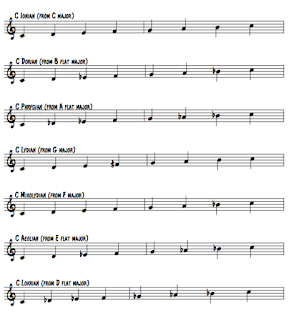Introduction:
Modes are a fundamental concept in music theory that play a crucial role in shaping melodies, harmonies, and overall tonalities in various musical compositions. Derived from ancient Greek musical traditions, modes have evolved over centuries and are still widely used in contemporary music. In this exploration of modes, we will delve into their historical origins, define each mode, discuss their distinctive characteristics, and provide examples from different musical genres to illustrate their application.
Historical Origins:
The concept of modes traces its roots back to ancient Greece, where music played a significant role in religious and cultural practices. The Greek modes were a system of organizing musical pitches and scales, primarily used in vocal music. These modes were associated with different emotional and psychological effects, with each mode expressing a unique mood or sentiment. The Greek modes served as the foundation for the development of modes in Western music.
Modes in Western Music:
In Western music, modes are derived from the major and minor scales, which are the building blocks of tonal music. The major scale serves as the basis for seven different modes, each starting on a different pitch within the scale. These modes are known as the Ionian, Dorian, Phrygian, Lydian, Mixolydian, Aeolian, and Locrian modes.
Ionian Mode:
The Ionian mode is the familiar major scale that we commonly associate with a happy or bright sound. It starts on the first note of the major scale and maintains the same sequence of intervals.
Dorian Mode:
The Dorian mode is often described as having a minor tonality with a raised sixth scale degree. It is commonly associated with a melancholic or introspective mood and is frequently used in jazz, blues, and rock music.
Phrygian Mode:
The Phrygian mode features a minor tonality with a lowered second scale degree. It has a distinctly exotic and mysterious quality and is often utilized in flamenco, metal, and progressive rock genres.
Lydian Mode:
The Lydian mode is characterized by a raised fourth scale degree, which gives it a unique and dreamy quality. It is frequently employed in film scoring and contemporary classical music to create a sense of wonder or suspense.
Mixolydian Mode:
The Mixolydian mode is commonly associated with blues, rock, and folk music. It has a dominant seventh chord built on the tonic and features a flattened seventh scale degree, which gives it a slightly bluesy or folk-like sound.
Aeolian Mode:
The Aeolian mode is identical to the natural minor scale and is often used in classical, pop, and rock music. It has a somber or melancholic quality and is frequently associated with introspective or emotional compositions.
Locrian Mode:
The Locrian mode is the darkest and least commonly used mode in Western music. It has a diminished fifth scale degree, giving it a dissonant and unstable sound. The Locrian mode is often employed in avant-garde or experimental compositions.
Applications of Modes:
Modes find application in various musical genres, including classical, jazz, rock, and folk. Understanding and utilizing modes allow composers and improvisers to add color, emotion, and variety to their compositions. Here are a few examples of modes in practice:
"So What" by Miles Davis:
The composition "So What" is a notable example of the Dorian mode. It features a modal jazz approach with the entire piece based on two Dorian mode scales, D Dorian and E♭ Dorian. This creates a cool and laid-back atmosphere.
"Scarborough Fair" by Simon & Garfunkel:
"Scarborough Fair" incorporates the Dorian mode, particularly in the melody of the verses







